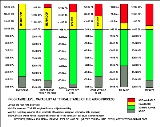
Headroom
Encyclopedia
In digital and analog audio, headroom is the amount by which the signal-handling capabilities of an audio system exceed a designated level known as Permitted Maximum Level (PML). Headroom can be thought of as a safety zone allowing transient audio peaks to exceed the PML without exceeding the signal capabilities of an audio system (digital clipping, for example). Various standards bodies recommend various levels as Permitted Maximum Level.
(decibels). The European Broadcasting Union (EBU) specifies a PML of 9 dB below 0 dBFS
(-9 dBFS), thus giving 9 dB of headroom. An alternative EBU recommendation allows 24 dB of headroom, which might be used for 24-bit master recordings where it is useful to allow more room for unexpected peaks during live recording.
Failure to provide adequate headroom can bring about clipping
of brief, higher-level transients.
is an 'anchor' point, 9 db below the nominal level, a reference level which exists throughout the system or broadcast chain, though it may have different actual voltage levels at different points in the analog chain. Typically, nominal (not alignment) level is 0 dB, corresponding to an analog sine wave voltage of RMS voltage of 1.23 volts (+4 dBu
or 3.47 volts peak to peak). In the digital realm, alignment level is −18 dBFS.
Headroom in digital audio
In digital audio, headroom is defined as the amount by which digital full scale (FS) exceeds the permitted maximum level (PML) in dBDecibel
The decibel is a logarithmic unit that indicates the ratio of a physical quantity relative to a specified or implied reference level. A ratio in decibels is ten times the logarithm to base 10 of the ratio of two power quantities...
(decibels). The European Broadcasting Union (EBU) specifies a PML of 9 dB below 0 dBFS
DBFS
Decibels relative to full scale, commonly abbreviated dBFS, measures decibel amplitude levels in digital systems such as pulse-code modulation which have a defined maximum available peak level....
(-9 dBFS), thus giving 9 dB of headroom. An alternative EBU recommendation allows 24 dB of headroom, which might be used for 24-bit master recordings where it is useful to allow more room for unexpected peaks during live recording.
Failure to provide adequate headroom can bring about clipping
Clipping (audio)
Clipping is a form of waveform distortion that occurs when an amplifier is overdriven and attempts to deliver an output voltage or current beyond its maximum capability...
of brief, higher-level transients.
Headroom in analog audio
In analog audio, headroom can mean low-level signal capabilities as well as the amount of extra power reserve available within the power amplifiers that drive the loudspeakers.Alignment level
Alignment levelAlignment level
The alignment level in an audio signal chain or on an audio recording is a defined anchor point that represents a reasonable or typical level...
is an 'anchor' point, 9 db below the nominal level, a reference level which exists throughout the system or broadcast chain, though it may have different actual voltage levels at different points in the analog chain. Typically, nominal (not alignment) level is 0 dB, corresponding to an analog sine wave voltage of RMS voltage of 1.23 volts (+4 dBu
DBU
DBU may refer to:* Dansk Boldspil-Union, in English known as the Danish Football Association* dBu, a decibel measurement of voltage* 1,8-Diazabicyclo[5.4.0]undec-7-ene...
or 3.47 volts peak to peak). In the digital realm, alignment level is −18 dBFS.
- AL = analog level
- SPL = sound pressure level
See also
- Audio quality measurementAudio quality measurementAudio quality measurement seeks to quantify the various forms of corruption present in an audio system or device. The results of such measurement are used to maintain standards in broadcasting, to compile specifications, and to compare pieces of equipment....
- Noise measurementNoise measurementNoise measurement is carried out in various fields.In acoustics, it can be for the purpose of measuring environmental noise, or part of a test procedure using white noise, or some other specialised form of test signal....
- Programme levels
- Rumble measurement
- ITU-R 468 noise weightingITU-R 468 noise weightingITU-R 468 is a standard relating to noise measurement, widely used when measuring noise in audio systems. The standard defines a weighting filter curve, together with a quasi-peak rectifier having special characteristics as defined by specified tone-burst tests...
- A-weightingA-weightingA Weighting curve is a graph of a set of factors, that are used to 'weight' measured values of a variable according to their importance in relation to some outcome. The most commonly known example is frequency weighting in sound level measurement where a specific set of weighting curves known as A,...
- Weighting filterWeighting filterA weighting filter is used to emphasise or suppress some aspects of a phenomenon compared to others, for measurement or other purposes.- Audio applications :...
- Equal-loudness contourEqual-loudness contourAn equal-loudness contour is a measure of sound pressure , over the frequency spectrum, for which a listener perceives a constant loudness when presented with pure steady tones. The unit of measurement for loudness levels is the phon, and is arrived at by reference to equal-loudness contours...
- Fletcher-Munson curves
- Loudness warLoudness warThe loudness war or loudness race is a pejorative term for the apparent competition to digitally master and release recordings with increasing loudness.The phenomenon was first reported with respect to mastering practices for 7" singles...
External links
- EBU Recommendation R68-2000
- AES Preprint 4828 - Levels in Digital Audio Broadcasting by Neil Gilchrist (not free)
- EBU Recommendation R117-2006 (against loudness warLoudness warThe loudness war or loudness race is a pejorative term for the apparent competition to digitally master and release recordings with increasing loudness.The phenomenon was first reported with respect to mastering practices for 7" singles...
) - AES Convention Paper 5538 On Levelling and Loudness Problems at Broadcast Studios
- EBU Tech 3282-E on EBU RDAT Tape Levels
- AES17-1998 (r2004): AES standard method for digital audio engineering -- Measurement of digital audio equipment

